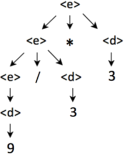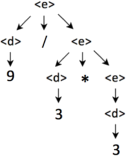CMPSC 461 Spring 2022
Hello, dear friend, you can consult us at any time if you have any questions, add WeChat: daixieit
CMPSC 461 Spring 2022
Homework 1 Solution. Gang Tan. Please do not upload the document to an online site such as coursehero.com.
1. (a)
<e> ‐> <e> / <e> ‐> <d> / <e> ‐> 9 / <e> ‐> 9 / <e> * <e> ‐> 9 / <d> * <e> ‐>
9 / 3 * <e> ‐> 9 / 3 * <d> ‐> 9 / 3 * 3
Another possible answer is: <e> ‐> <e> * <e> ‐> …
1. (b)
<e> ‐> <e> * <e> ‐> <e> * <d> ‐> <e> * 3 ‐> <e> / <e> * 3 ‐> <e> / <d> * 3 ‐>
<e> / 3 * 3 ‐> <d> / 3 * 3 ‐> 9 / 3 * 3
Another possible answer is: <e> ‐> <e> / <e> ‐> …
1. (c)
For (a):

For (b):

Note: depending on the answers for (b) and (c), it’s possible that the parse trees for the two derivations are the same (one of the above).
1. (d)
<e> ‐> <d> | <e>/<d> | <e>*<d>
<d> ‐> 0 | 1 | 2 | 3 | 4 | 5 | 6 | 7 | 8 | 9
The parse tree for “9 / 3 * 3” based on the new grammar:

Argument for unambiguity: there are two choices to begin parsing 9/3*3:
(1) <e> ‐> <e>/<d> or (2) <e> ‐> <e>*<d>
For option (1), it is impossible to get the expression 9/3*3 from <e> ‐> <e>/<d> ‐> <e>/3 ‐> <e>*<d>/3. For option (2), it is shown above. Hence, (2) is the only choice.
1. (e)
<e> ‐> <d> | <d>/<e> | <d>*<e>
<d> ‐> 0 | 1 | 2 | 3 | 4 | 5 | 6 | 7 | 8 | 9
The parse tree for “9 / 3 * 3” based on the new grammar:

2.
The grammar is ambiguous.
Example input: 123
Corresponding parse tree 1:

An equivalent unambiguous grammar:
<n> ‐> <n><d> | <d>
<d> ‐> 0 | 1 | 2 | 3 | 4 | 5 | 6 | 7 | 8 | 9 3. <S> ‐> ()) | (<S>))
4.
<e> ‐> <u> | <e> + <u> | <e> ‐ <u>
<u> ‐> <d> | ~ <u>
<d> ‐> 0 | 1 | 2 | 3 | 4 | 5 | 6 | 7 | 8 | 9
parse tree 2:

5.
<email> ‐> <account> @ <subDomains> . <topDomain>
<account> ‐> <letter> | <account><letter> | <account><digit>
<subDomains> ‐> <letterDigitSeq> | <letterDigitSeq> . <subDomains>
<letterDigitSeq> ‐> <letter> | <digit>
| <letter><letterDigitSeq>
| <digit><letterDigitSeq>
<topDomain> ‐> com | org | gov | net
<letter> ‐> a | b | c | ... | z | A | B | C | ... | Z
<digit> ‐> 0 | 1 | 2 | 3 | 4 | 5 | 6 | 7 | 8 | 9
6. BNF grammar:
<SNFloat> ‐> <Float> | <Float>E<Exponent>
<Float> ‐> <NonZeroDigit> | <NonZeroDigit>.<Num>
<Exponent> ‐> <Num> | +<Num> | ‐<Num>
<Num> ‐> <Digit> | <Digit><Num>
<Digit> ‐> 0 | <NonZeroDigit>
<NonZeroDigit> ‐> 1 | 2 | 3 | 4 | 5 | 6 | 7 | 8 | 9
2022-02-12